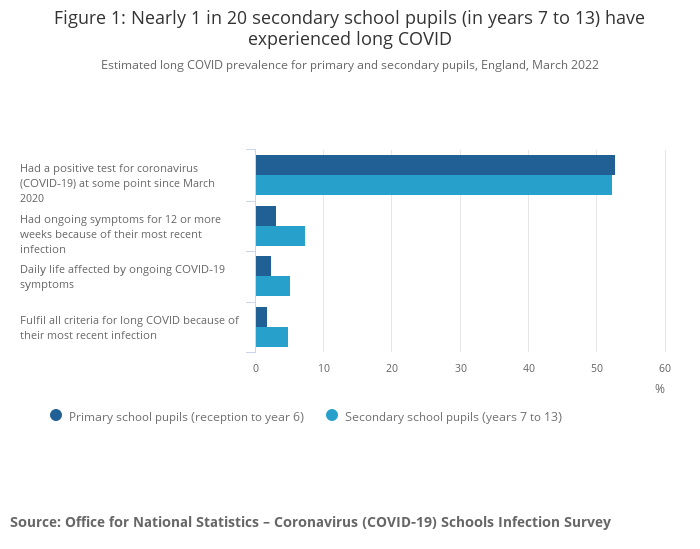Almost one in 20 secondary school pupils experienced symptoms of long Covid following their most recent infection, and those who did are much more likely to have a probable mental health disorder, new data suggests.
Data from the school infection survey, published by the Office for National Statistics, estimates that 4.8 per cent of secondary pupils and 1.8 per cent of primary pupils had symptoms that persisted for 12 or more weeks after a coronavirus infection as of March.
Regular ONS data on the population more generally is not directly comparable, because it asks people if they are currently suffering from long Covid, whereas the school survey asks if pupils have had symptoms after any infection since March 2020.
However, findings from larger studies last year suggested that by that point, 5.8 per cent of the population had had long Covid.

The proportion of school pupils with long Covid has increased since the last survey, which took place in November and December last year, and found 2.7 per cent of secondary pupils and 1 per cent of primary pupils had the symptoms.
However, the ONS said the rise was not statistically significant, and likely due to an increase in infections.
Nevertheless, the findings are likely to further exacerbate fears about the long-term impact of Covid in schools.
It comes as the latest government estimates for the wider population showed those working in teaching and education had the second highest rate of long Covid, higher than health care workers and second only to social care staff.
The data suggests 4.6 per cent of education workers had long Covid as of May.
TES reported that education secretary Nadhim Zahawi has asked officials to draw up guidance for schools on how to tackle long Covid.
Long Covid kids more likely to report heart symptoms
The study, which is based on a survey of pupils, parents and headteachers, found secondary pupils who had tested positive for Covid were “significantly more likely” to have experienced systemic and cardiovascular symptoms than those who had not.
Almost a quarter (22.1 per cent) of those who had Covid experienced systemic symptoms such as fever or high temperature, chills or shivers, weakness or tiredness, compared to 14.4 per cent of those who had not had the virus.
And 8.5 per cent of those who had tested positive had ongoing cardiovascular symptoms, compared to 4.5 per cent of those with no reported Covid.
Long Covid is also having a negative impact on pupil mental health, the study suggests.
It found that 28.1 per cent of secondary pupils with long Covid had a probable mental health disorder, compared to 12.3 per cent of those without long Covid.
Primary pupils with long Covid were also more likely to have a probably mental health disorder (18.9 per cent vs 11.3 per cent), but the ONS said the difference was not “statistically significant”.

Mental health disorders rise in primary pupils
Overall, the survey found the proportion of primary pupils with a probably mental health disorder had increased “significantly”, from 8 per cent in December to 11.4 per cent in March.
The prevalence in secondary pupils fell slightly, from 13.8 per cent to 13 per cent over the same period. A further 8.3 per cent of primary pupils and 10.7 per cent of secondary pupils had “at least one possible mental health disorder”, the study found.
Of three disorders analysed, probably hyperactivity disorders had the highest prevalence for primary pupils (8.3 per cent) and secondary pupils (8.7 per cent).
This was higher than probably emotional disorder prevalence (2.6 per cent and 3.4 per cent) and probably conduct disorder prevalence (3.3 per cent and 2.5 per cent).















Your thoughts